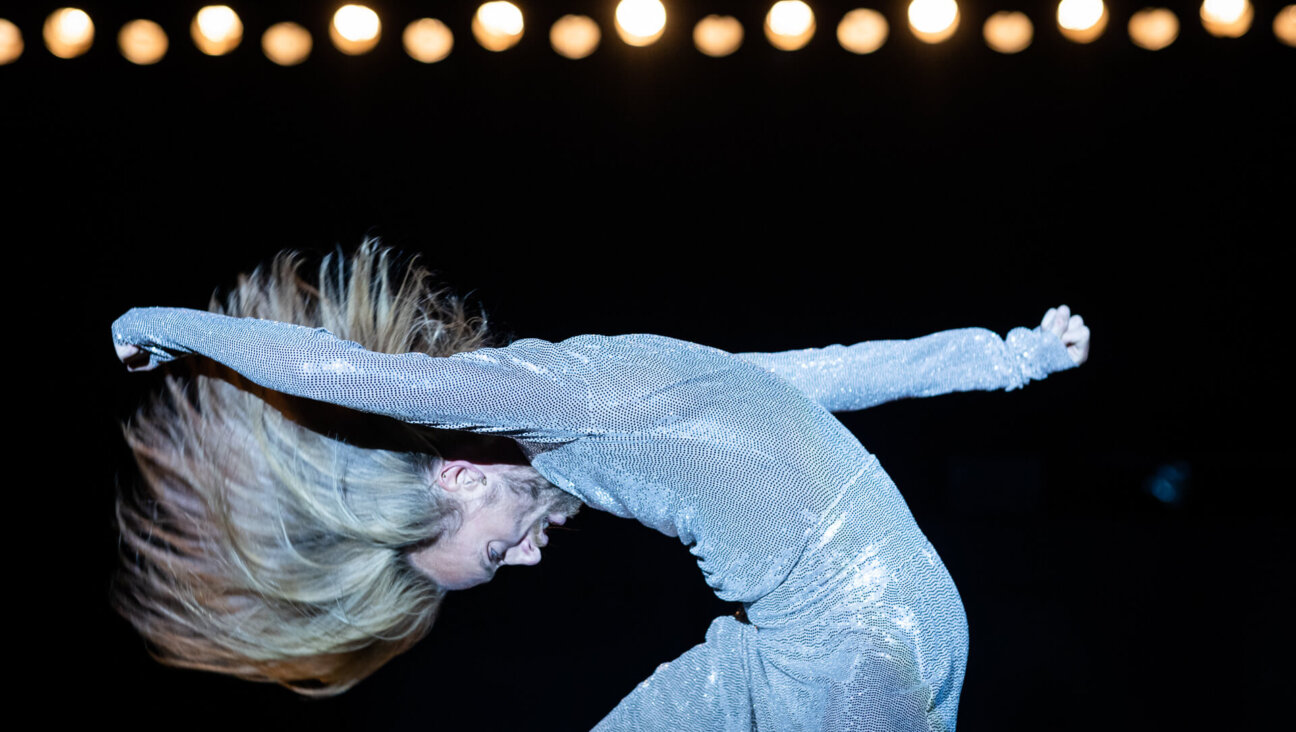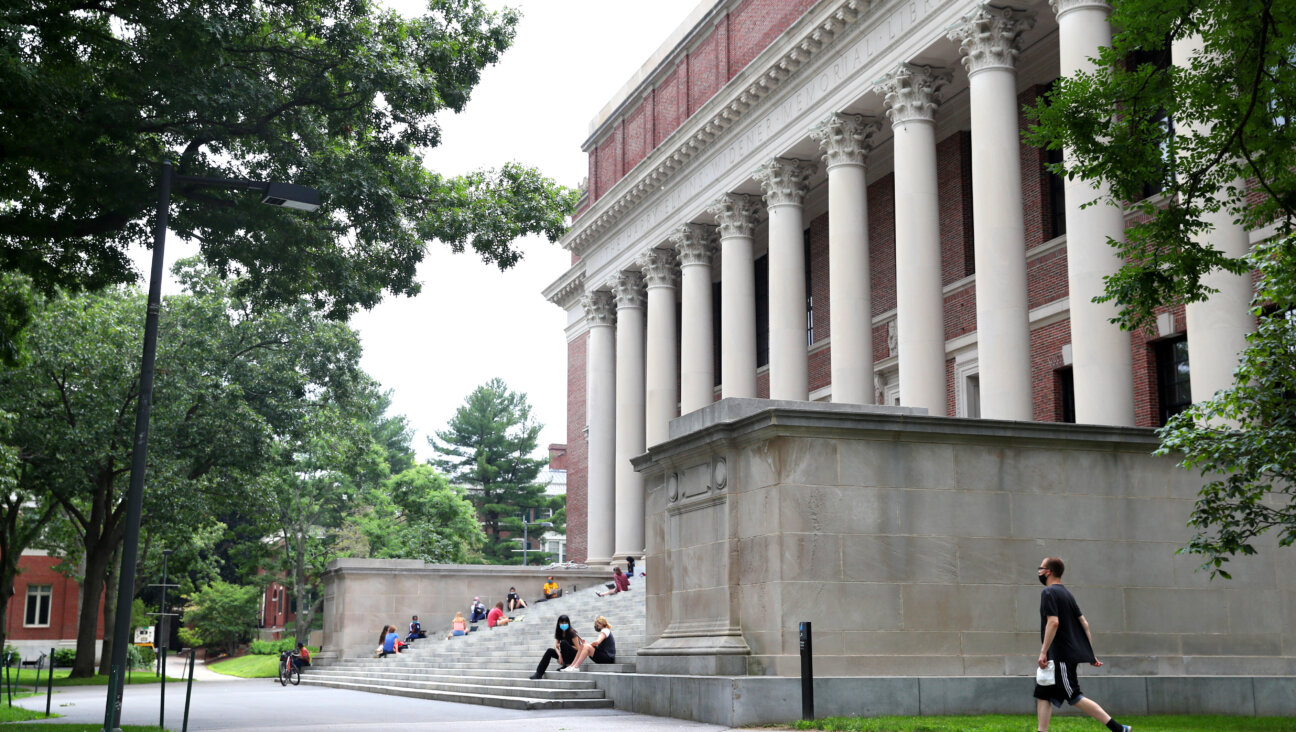Jew as Metaphor Quick! Crush This Philosemitism Before It Gets Out of Hand
Suicide bombers in Jerusalem, swastikas in Brooklyn, synagogue fires in Europe, so-called intellectuals shunning Israeli colleagues: Not since 1945 have Jews felt so threatened. Yet Jews have faced political resentment and theological mania for millennia. What’s new today is a subtler danger that the Jewish community has utterly failed to recognize. We must stamp out philosemitism wherever it rears its ugly head.
At the same time as cartoons of hook-nosed monsters devouring bloody matzos proliferate in the press of Muslim nations and an elegant fecal burp slips between the lips of the ambassador to England from some “shitty little country,” a perverse affection for Jews is growing throughout American culture. Max Bialystock and Leo Bloom sing to sold-out audiences every night on Broadway, and minyans’ worth of Jewish characters fill out the ensembles on TV shows ranging from “West Wing” to that epitome of bland network pudding, “Friends.” The whole sequence of “Chicken Soup” best-sellers relies on a recipe of soothing Semitic shmaltz for its success. And it recently turned out that one of Marvel Comics’ favorite super heroes has at least one ancestor of the Hebrew persuasion in his genetic woodpile. At first glance, this wave of benevolent identification must comfort Jewish worriers, but philosemitism is just as dehumanizing as antisemitism and, because it masquerades as its opposite, more insidious.
Take last summer’s much ballyhooed issue of Fantastic Four in which the orange-skinned Thing, who resembles a heap of bricks dumped off the back of a truck, comes out as he murmurs at a moment of extreme stress, “Sh’ma Yisrael.” Occurring as this revelation does 41 years after the Fantastic Four’s debut, it raises more questions than answers. Sources at Marvel Comics claim that they always knew that the Thing was Jewish, but when other characters’ origins have been lovingly recounted over and again it’s hard to believe that it simply didn’t occur to the editors to mention the Thing’s heritage until now.
Joining the Thing on the klezmer bandwagon in L.A. is pop singer Madonna as she shleps her husband to kabbala “ceremonies.” Never mind that there are no such things. Apparently the material girl needs immaterial sustenance. But the Jews who built Hollywood were more interested in shekels than the Shekhina. The day that Louis B. Mayer consulted the Zohar for moral guidance would be a blue moon in Elul.
It doesn’t make a difference that it was Jews who created the Fantastic Four, as they did the original comic book hero, Superman. Nor does it make a difference that the Fantastic Four is a serial vineyard in which many writers and illustrators of different religions have labored. Gentile and Jewish philosemitism are equally repugnant. Ain’t ecumenicism grand?
Jews have long been repositories of social imagery. Communist to the capitalist, capitalist to the communist, sleek and oily sexual predator to the pigtailed virgin or cringing castrati to the Nordic he-man, the Jew has provided a convenient blank slate upon which to etch the image of a perceiver’s anxiety. This was as true in the time of Matthew 23 — “You serpents, you brood of vipers” — as it is today when conflict in the Middle East rouses the drowsing beast of race hatred.
Mind, images differ from stereotypes because the former reflect more upon the creator than upon the subject while the latter have origins in truth. Such images become illegitimate only when they extrapolate the qualities of the few to the many, or of the many to the all. For example, Jews have long been interested in books because their valuables needed to be portable when exile was always imminent. Yes, the same goes for money.
Many cliched images of Jews emerge from secular ideologies that have developed out of a distinctly Jewish consciousness: the Marxist firebrand, the Freudian analyst or, my favorite, the New York intellectual. Most of these are double-edged, however, an object of simultaneous admiration and distrust — like the Thing.
We’re in transit now from the crudely negative to the mediated, en route to something entirely new, the pure. In this generation, the Jewish sinner has been miraculously transformed into the Jewish saint. This image begins with the Holocaust survivor — sorrowful, soulful, suffering: Elie Wiesel as Jesus. Forget about what Wiesel the man or Wiesel the writer may be; what purpose does Wiesel the symbol serve? Well, the suggestion that all survivors are saints implies the despicable corollary that all the dead were sinners — and we’re better off without them.
Politically, the image of the righteous Jew has been drawn upon by the Christian right as it has become Israel’s staunchest supporter in Congress. These zealots have an agenda of their own because their faith requires the Jews’ return to Zion to hearken in their own messianic age. We are the precondition of their redemption; after that, we’re chopped liver.
In response, a friend of mine says that he has no problem accepting the fundamentalists’ “temporary” assistance because he feels quite certain that the messiah is not arriving on the next mule train from Jerusalem. The logic here is that an embattled minority needs all the help it can get, but I know who my friends are and they don’t listen to country and Western. Zionists like the Rev. Jerry Falwell are just as bad as bigots such as Father Charles Coughlin.
This season, books by Richard Powers and Zadie Smith introduce Jewish — or half-Jewish — main characters. Powers’s émigré physicist David Strom loses his “mother and father, his sister” in Holocaustal Europe and still raises his children to be virtually ignorant of their history. At 7, his son Joseph asks why a local baker’s arm is “numbered.” Later Joseph and his brother Jonah travel to Germany to sing Teutonic lieder without a trace of anxiety, rage or even irony.
It’s vital to note that Powers’s “The Time of Our Singing” (Farrar, Straus & Giroux, 2003), otherwise passionately engaged with music, physics, justice and human loneliness, is one of the most glorious books of our time. We’re lucky to have it. Nonetheless, if its characters’ interest in their own Jewishness is tepid at best, why does the author bother? And while Powers’s Jewishness recedes into ontological mist, Smith capers to giddy nullity amid images of British suburban Judaica as her protagonist in “The Autograph Man” (Random House, 2002), Alex-Li Tandem, enters into his career of insipid celebrity-mongering autograph collecting.
Granted, both Powers and Smith clearly have other points to make that may keep them from delving further into their characters’ religious identities. But in both cases the choice of character is also an act of presumption that is reluctant to take full responsibility for its concept. It’s not enough to stand in amazement at one’s daring empathy: “Look, a Jew!”
Oddly, few Jews complain about their spiritual stature. In an age of victimization, the undisputed high place on the totem pole of suffering entails many benefits. How nice to sit somberly at Yom HaShoah ceremonies while presidents and popes ritually abase themselves before the dubious knowledge born of pain. And it’s even easier to sit at home, yukking it up as reruns of “Seinfeld” play for the 100th time that week — what naches!
It’s hard to blame them — us — for taking solace in virtuous images, but let’s do so anyway. The only reason Jews can abide such fraudulent bunk is because we’re so deracinated that we can’t see ourselves and therefore need someone else to tell us who we are. Having lost all touch
with the moral, historical, ritual underpinnings of our faith, we are left with only the gastronomic Sunday morning sacrament of bagels and lox while kvelling at the latest sanctimonious blather of Steven Spielberg, whose soft-focus universalist empathy is… goyish.
Of course, Spielberg himself is the image of the Jew, too, warm and fuzzy but rich as Rothschild, giving money to collect Holocaust testimonies as avidly as Alex-Li Tandem collects autographs on the profits of a movie that implies that the protagonist of the Holocaust was a good German. Pathetically, his lack of self-knowledge is probably the most defining trait of Judaism today.
Until now, Christians have been very interested in Judaism because it’s where their faith came from, but they have never cared much for living, breathing Jews. On the other hand, Jews have never been particularly interested in Christianity because the “New” Testament is a barnacle on the ark of the Bible, but we’ve always been very interested in Christians, mostly because we want to know if they’re going to kill us.
Now the dynamic is turned askew. Most Jews, except for those in cultish enclaves ranging from Brooklyn’s chasidim to Berkeley’s new-age navel-gazers, are no longer very interested in Judaism and have left Bible study to the gentiles, while Christians can’t get enough of Jews.
In the midst of this symbiotic love fest, the only ones who upset the applecart of good and evil — and even they can’t deter their admirers in Congress — are the Israelis. After all, they defend their children, and some of them even want vengeance on people who blow up their pizza parlors. How dare they ask whether, if the Palestinians’ much-desired “right of return” was exercised and the Knesset surrendered every last inch of Mediterranean beachfront, Gaza would soon resemble Tel Aviv or, in short order, Tel Aviv resemble Gaza.
As modernity proves a more implacable enemy than fascism and Diaspora Jews finally fulfill their meager assimilationist fantasies and evaporate into greater society, the Israelis who once seemed a breed apart have finally become Jews. Yet they are neither soulful European survivors nor gabby Borscht Belt shtick-figures. No, they’re more like Old Testament prophets armed with new technology. And instead of a Christian message of mercy, they declare: No more light unto the nations.
What philosemites who keep seeking illumination from us don’t get is that humanity is defined as much by its flaws as its virtues. That’s why Shakespeare’s “If I Am a Prick, Do I Not Bleed?” Shylock does not seem antisemitic. Instead he is, though undeniably Jewish, merely — merely! — human. That’s also why the best Jewish writers or filmmakers like, say, Billy Wilder, are not philosemites and why the I.B. Singer of the bruisingly raw “Shadows on the Hudson” is a far greater artist than is his later incarnation as the genially oversexed imp of “Fiddler”-style yidishkayt. Of course, it’s also why the latter Singer was more successful than the former. By burying our artists’ most authentic work in the archives while exalting their subsequent accommodations we help the larger culture celebrate diversity by obliterating it.
Is this a “damned if you do…” argument? Well, yeah; life is tough. Remember, Jews are exactly the same as other people. We just want to rape and pillage like everyone else.
The Forward is free to read, but it isn’t free to produce

I hope you appreciated this article. Before you go, I’d like to ask you to please support the Forward.
Now more than ever, American Jews need independent news they can trust, with reporting driven by truth, not ideology. We serve you, not any ideological agenda.
At a time when other newsrooms are closing or cutting back, the Forward has removed its paywall and invested additional resources to report on the ground from Israel and around the U.S. on the impact of the war, rising antisemitism and polarized discourse.
This is a great time to support independent Jewish journalism you rely on. Make a Passover gift today!
— Rachel Fishman Feddersen, Publisher and CEO
Most Popular
- 1

News Student protesters being deported are not ‘martyrs and heroes,’ says former antisemitism envoy
- 2

News Who is Alan Garber, the Jewish Harvard president who stood up to Trump over antisemitism?
- 3

Fast Forward Suspected arsonist intended to beat Gov. Josh Shapiro with a sledgehammer, investigators say
- 4

Politics Meet America’s potential first Jewish second family: Josh Shapiro, Lori, and their 4 kids
In Case You Missed It
-

Opinion Why can Harvard stand up to Trump? Because it didn’t give in to pro-Palestinian student protests
-

Culture How an Israeli dance company shaped a Catholic school boy’s life
-

Fast Forward Brooklyn event with Itamar Ben-Gvir cancelled days before Israeli far-right minister’s US trip
-

Culture How Abraham Lincoln in a kippah wound up making a $250,000 deal on ‘Shark Tank’
-
Shop the Forward Store
100% of profits support our journalism
Republish This Story
Please read before republishing
We’re happy to make this story available to republish for free, unless it originated with JTA, Haaretz or another publication (as indicated on the article) and as long as you follow our guidelines.
You must comply with the following:
- Credit the Forward
- Retain our pixel
- Preserve our canonical link in Google search
- Add a noindex tag in Google search
See our full guidelines for more information, and this guide for detail about canonical URLs.
To republish, copy the HTML by clicking on the yellow button to the right; it includes our tracking pixel, all paragraph styles and hyperlinks, the author byline and credit to the Forward. It does not include images; to avoid copyright violations, you must add them manually, following our guidelines. Please email us at [email protected], subject line “republish,” with any questions or to let us know what stories you’re picking up.











